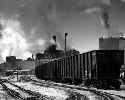Sunday, May 31, 2009
Necedah national wildlife refuge - Trumpeter swans
Saturday, May 30, 2009
The migration of the loon
Late autumn at Devils Lake Wisconsin
Friday, May 29, 2009
View a top north bluff - time lapse
Spring view a top north bluff - Sandhill wildlife area, Wisconsin
Time lapse photography
Double crested cormorants in roost
The double crested cormorant are one of the most adaptable birds in the great swamp, they can fly, swim, dive and nest in trees or on the ground in and around the uplands and wetlands. These magnificent birds can keep the keenest bird watcher guessing.
Sunday, May 24, 2009
Spring in central Wisconsin
The credit to the photographs made during spring goes to the singing wildlife in the wetlands. The music around the wetlands is near deafening. All spring songs are composed to perfection. The spring peepers in rhythm, the air pump base of the American bittern is deep and throaty, the Sandhill cranes call coarse and raspy, an occasional clap of thunder causing the wild turkey to shock gobble, in the fare distance the drumming of the ruffed grouse, overhead the whisper of the woodcock. The annual live spring performance in the Wood county wildlife area is purely unequalled.
The portfolio below was selected from several photographs that were taken during the spring of 2009.

Bad wetland weather - Wood county wildlife area
 Canada geese with goslings - Necedah national wildlife refuge
Canada geese with goslings - Necedah national wildlife refuge
Spring light - Necedah national wildlife refuge
 Spring shore - Wood county wildlife area
Spring shore - Wood county wildlife area  Wetland prairie - Wood county wildlife area
Wetland prairie - Wood county wildlife area
Wetland rainbow - Wood county wildlife area Forest in down pour - South wood county park, Dexterville Wisconsin
Forest in down pour - South wood county park, Dexterville Wisconsin Rainbow and bloom - South wood county park, Dexterville Wisconsin
Rainbow and bloom - South wood county park, Dexterville Wisconsin Lilly pads - Sandhill wildlife area
Lilly pads - Sandhill wildlife area Water drops and tree reflection - Sandhill wildlife area
Water drops and tree reflection - Sandhill wildlife area
 Birch reflection - Necedah national wildlife refuge
Birch reflection - Necedah national wildlife refuge Moore road - Wood county Wisconsin
Moore road - Wood county Wisconsin Black river - Black river falls, Wisconsin
Black river - Black river falls, Wisconsin Sandpiper - Wood county wildlife area
Sandpiper - Wood county wildlife area Hooded merganser - South wood county park, Dexterville Wisconsin
Hooded merganser - South wood county park, Dexterville Wisconsin Muskrat - Wood county wildlife area
Muskrat - Wood county wildlife area
Saturday, May 23, 2009
Grasshopper and black-eyed Susan's

Tiger swallowtail butterflies “mud-puddling”

Wednesday, May 20, 2009
2 mile perch of red wings

Spring acrobatics of the woodcock

Tuesday, May 19, 2009
Wazee "tall pine" and much more
To express my mood I used a gold and blue polarizing filter to create the photo “Box Alder”. The photo “Contrails” was taken near sun down of jet contrails adrift.

Sunday, May 17, 2009
Necedah national wildlife refuge rarities
Both of the photographs below are rare scenes.
The photo titled "Shelf cloud" shows the purest expression of the bowing arc of a shelf cloud. "Shelf cloud" may very well be a once in a lifetime opportunity in the Necedah national wildlife refuge.
Back yard rainbow
An evening around Wisconsin Rapids
Bobbin robin

Monday, May 11, 2009
Words about climate change
 Shelf cloud before a major storm - Necedah National Wildlife Refuge
Shelf cloud before a major storm - Necedah National Wildlife RefugeThe day is warm, gray and rainy. The Necedah National Wildlife Refuge has many migratory birds around the Sprauge Mather flowage. Wandering about the wetlands I notice a dozen or so trumpeter swans, several gulls, fair numbers of great blue heron, and many species of ducks dunking their heads under the warm water and fueling up for the journey ahead. The sky, suddenly awakened by a grand flock of sandhill cranes gliding overhead. The sound of Canada geese ringing throughout the flowage. The moment is simply a paradise for a bird watcher. Paradise with a poignant reality, the large number of migratory birds is a rarity at this time of year. Have their migrations been altered due to global warming? Very content, the migrants may not know what terrifying potential is progressing season after season. The wake up call for some is a smog warning in southern Wisconsin. The alert suggests the air they're breathing may not agree with their health. The WARNING is obvious.
Journals conclusion:
“Whether or not you believe in climate change, the earth remains the soul proprietor of life. Those that occupy this planet must be responsible tenants. For as if we don’t care for our existence today; our kin indubitably will.”
Winter impressions

Forest with dappled leaves








































